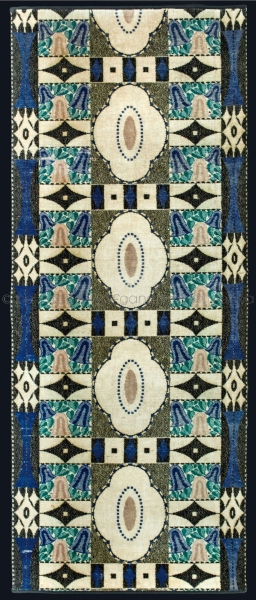The beginnings of the Backhausen textile company lie in Brühl in the Rhineland, where Jakob Backhausen was born as the son of master weaver Wilhelm Backhausen and completed an apprenticeship in his father's business. When the French troops under Napoleon invaded, Jakob fled to Vienna, where he acquired the right to work as a master weaver and, from 1815, produced ladies' coat, vest and horsehair fabrics on 40 hand looms. His sons Karl and Johann took over the business in the year of their father's death and founded the company "Karl und Johann Backhausen & Co" in 1848. After Karl's retirement, the company was renamed "Johann Backhausen k. k. ausschließlich privilegierten Mode- und Chenillewarenfabrik" in 1853.
[...] In 1857 Johann Backhausen patented the invention of "fabrics made of gauze, thin cloth, tulle etc. with double right designs on both sides".
This was followed in 1860 by a chenille product on a gauze base in silk and cotton, patented in France and Austria. Obviously, Johann Backhausen already had an extensive export network at this time, as the press reported in the same year on a "new chenille fabric from Backhausen which was particularly popular abroad". [...]
The choice of the new business premises on Opernring in 1864 turned out to be a real hub for the company. In 1869, the Backhausen company produced parts of the furnishings for the Opera House, followed by the furnishings for the Parliament in 1883, the Vienna City Hall and the Burgtheater as well as the Academy of Fine Arts in 1888. In 1869 Johann Backhausen joined the Österreichischer Kunstverein and the Verein zur Förderung der Kunstgewerbeschulen.
In 1872, Johann Backhausen leased an abandoned glass factory in Hoheneich, in the northern Waldviertel, which he acquired in 1874 and continuously converted into a modern weaving mill. [...] In 1899, the Backhausen company was obviously not only equipped in terms of weaving technology, but also had the capacity, the understanding and the entrepreneurial spirit to devote itself to truly pioneering work and extensively implement completely new surface patterns for textiles, initially by the Secessionists and later by the Wiener Werkstätte. At the Secession exhibition in 1899, "Moser's designs for fabrics, woven and knotted, which the Backhausen company executed excellently" were used for the first time.
In 1899, Backhausen participated for the first time with Moser's designs in the Austrian Museum's winter exhibition, which had already been well established since 1871.
[...] Backhausen had become the first address for experimental textile design. As early as 1898, Otto Wagner had developed his first designs with "Joh. Backhausen & Söhne", as had Robert Oerley, followed by Alfred Roller, Koloman Moser and Josef Hoffmann.
This is also evidenced by numerous prestigious interior design commissions that were carried out up until the First World War, including the Stadtbahnstation-Hofpavillon (1899), the Postsparkasse building (1904-1911), the Westend Sanatorium in Purkersdorf (1904), the Cabaret Fledermaus (1907), the Villa Ast (1911) and the Villa Skywa-Primavesi (1914), to name but a few. But large-scale commissions also became more frequent. It was now mainly carpets that proved the efficiency of the long-renowned carpet house Johann Backhausen & Söhne.
In 1907, Backhausen supplied around 2,000 m2 of carpets of all qualities to the newly opened Lower Austrian state sanatorium and nursing home Am Steinhof.
The slump in production due to the two world wars is particularly evident in the company archive. Nevertheless, the collaboration with trend-setting artists and architects such as Dagobert Peche, Otto Prutscher, Josef Frank and My Ullmann continued in the 1920s and 1930s. During the Second World War, Hoheneich primarily produced tarpaulins, uniform fabrics and flags. Just before the end of the war, the company headquarters in Heinrichshof were completely destroyed and the factory equipment in Hoheneich was devastated during the Russian occupation. Only the company archive survived the turmoil of war undamaged in the business premises at Kaiserstrasse 12.
After the Second World War, the Backhausen company was able to quickly regain a foothold through numerous prestigious orders in the course of reconstruction and opened a new sales branch in 1951 at Kärntnerstrasse 33 in Vienna I. In 1970, Backhausen was awarded the "Austrian national coat of arms". In 2003, the location at Kärntnerstraße 33 in Vienna I was given up for a store at Schwarzenbergstraße 10 in Vienna I.
Ref.: comp: E. Ottillinger (ed.), Wagner, Hoffmann, Loos und das Möbeldesign der Wiener Moderne, Vienna, 2018, p. 135 ff

 BOX
BOX  CARPET
CARPET